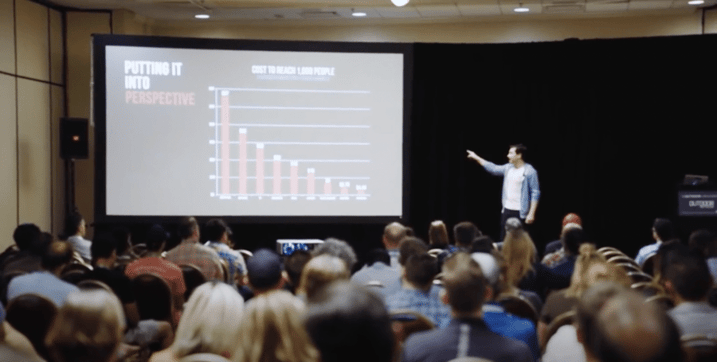What is the number one, most important piece of the business success puzzle?
The sales strategy. Plain and simple.
You can have the best product or service, marketing strategy, and team members ever, but if you can’t sell, then the business literally doesn’t exist.
With that said, CEOs and sales team leaders must always be on the lookout for potential breaks in their sales strategy. Because, the moment the sales strategy starts to break is the moment that the entire business comes to a head.
But, how do business leaders know when their sales strategy is starting to break down?
These ten signs are excellent indicators of a broken sales strategy. If you see one of these happening in your business, then getting back to the strategy drawing board is a must!
Now without further ado, do you see one of these signs in your business?
1. You've Hit a Sales Plateau
The most obvious sign that your B2B sales strategy is broken is that you’ve hit a sales plateau.
A sales plateau is the point at which the rate that you make new sales levels off. You are no longer making more and more sales from week to week as you were in previous months.
Instead, the number of sales that you and your sales team make stays the same overtime. Or, even worse, your sales begin to decline.
The worst part is that you and your team don’t understand why!
A sales plateau is a complicated issue because it could be the result of any one or many small pieces of your sales strategy going wrong. For example, it could be due to a:
- Lack of qualified leads
- Lack of synergy with the marketing strategy
- Decline in cold calling or emailing performance
- Combination of all of the above!
Moreover, a sales plateau can be the result of many issues or just one, and identifying the exact issue(s) can be extremely challenging!
However, what is good to know is that all of the causes of sales plateaus are rooted in one specific problem: complacency.
Complacency = getting too comfortable = endless opportunities for sales strategy to break.
Here is how it usually works: At one point or another, you and your fellow business leaders get comfortable with where you are at, and your standards for what is acceptable begin to slip. Complacency then manifests itself into a copious amount of issues with the sales strategy, which then results in a sales plateau.
If you hit a sales plateau, don't panic! Here is exactly what you should do:
- Understand that complacency has caused you to become too comfortable with your standards
- Identify how that complacency is causing your sales strategy to break and create a plateau
- Check your complacency to fix the break in the strategy and overcome the plateau
What is comforting to know is that sales plateaus happen to almost every business at one point or another.
However, if properly taken advantage of, plateaus can actually be a kickstarter for even stronger sales success in the future!
Don’t let complacency cause your sales strategy to fall apart, and then lead to a plateau.
If you see that flatline creep up, waste no time correcting the real issue, and then patching up the broken pieces of the strategy.

2. Your Prospects Don't Know Who to Talk to
The foundation of B2B sales success is the relationship between you and your B2B customer. Solid customer relationships are the basis for creating a cohesive and long lasting partnership.
Not only should the salespeople and CEO of your company have a relationship with the decision makers of your prospect company, but you should also intend on creating a large-scale relationship between their company and yours.
Moreover, B2B relationships aren’t just between a salesperson and decision maker, but between two entire companies for the sake of mutual benefit.
However, one potential side effect of forming such a large scale relationship is poor communication channels. When so many people are talking across borders, it’s easy for prospects to get confused on who exactly is their primary source of communication.
If your prospects or existing customer base ever has to ask the question, “who do I talk to for this?”, then odds are that the lines of communication in your sales strategy need some cleaning up.
More specifically, you need to focus on creating clear communication channels and touchpoints within your strategy.
It’s fantastic to have large scale relationships, but not if your prospects don’t know who to go to when they have hard questions to ask. The last thing you want is for them to feel confused or frustrated!
Therefore, make it a point to form clear lines of communication from the onset of the relationship. There should be one or several primary account managers, and then things can fan out from there.
Strong business relationships are essential to success, but if they’re messy, they’re doing the opposite of what they intend to do! Clean up the lines of communication in your sales strategy to ensure a strong relationship with your prospect or existing customer company!
3.Your Prospects Don’t Ask Questions Throughout the Sales Process
One of the primary goals of your sales strategy should be to uncover as much information about your prospects as possible, particularly during the early discovery phases of the sales cycle.
The most important thing to uncover about them is their pain points. By pain points, we mean their surface level problems AND any underlying issues lurking beneath the surface.
The only way to uncover those pain points is to get your prospects talking! And, not just talking, but asking questions.
When your prospects ask questions, it means that a level of trust has been established, and they are more likely to open up and share their pain points with you. Furthermore, it means that they see themselves wanting to have a relationship with you!
On the other hand, if your prospects aren’t asking questions, it’s a good sign that they still don’t feel like they can enter that phase with you. For some reason, your sales strategy has been crafted in a way that makes them not want to open up to you and share their real troubles.
Therefore, it’s your job to get them back on the track of trusting you and forming a relationship. Perhaps the best sign that they are on that track is if they ask questions!
But, what would make them feel as if you are untrustworthy in the first place, and therefore not want to ask questions? It could be the result of a few issues with your sales strategy, including:
- Your sales approach is too aggressive
- You don’t seem invested in solving their problems
- You are disengaged or unenthusiastic
Moreover, if some aspect of your sales strategy rubs your prospects the wrong way, they are less likely to feel like they can trust you and ask questions.
Remember, prospects remember how you make them feel more than anything! If your strategy gives them negative feelings, you can say goodbye to closing the deal.
If your prospects just sit back in silence while you do the talking, consider whether or not your strategy is formulated in a way that makes your prospects want to open up to you. If you were in their shoes, would you feel comfortable talking to you?
Once your prospects start asking questions, you will know that you’ve properly reconfigured your strategy in a way that makes them feel like they can trust you more!
4. Your CRM Data is a Mess
When you look at your CRM data, does it look like a tornado just blew through it? If so, then you’re probably better off not using it!
Online sales tools can be a godsend for connecting with and understanding prospects, as well as automating processes within your sales strategy. But, they are only beneficial if they are thought out and organized.
If your data is a mess, then it’s really challenging to use it to understand anything about your customers and keep track of them. If that’s the case, it’s no secret that your sales strategy is broken!
Data on your prospects and existing customers can be either beneficial or detrimental. When it’s beneficial, it can give you valuable insights into your customer base. When it’s detrimental, it can:
- Cause you to waste a lot of time
- Give you misleading information about your prospects and customers
Moreover, if your data is a mess, odds are that you don’t know your target customers as well as you think you do!
A healthy sales strategy is a clean one, and an unhealthy one is a mess! The first and easiest place to identify that mess is in your CRM data.
However, keep in mind that cleaning up your CRM data isn’t enough. You also need to make sure that you’ve got a process for keeping it tidy in the future!

5. Prospective Customers Don’t Respond to Follow-Up
Every salesperson has been there before: You nail the initial sales meeting, and your potential customer seems super enthusiastic about you and your solution. Right after the meeting, you send them a detailed follow-up email, ready to dive into the next steps.
But then, you are met with radio silence.
What you thought would be a quick response soon turns into hours, and then days of waiting. Before you know it, weeks have passed and your prospect has practically vanished.
If you’ve properly done your homework in terms of qualifying your leads, then this kind of a situation should never happen. If it does happen though, it’s a good sign that your sales strategy doesn’t allow you to take control of your sales process.
The number one reason why prospects don’t respond to follow-up is because you don’t control the process from beginning to end!
Without control integrated into your strategy, it's almost impossible to close deals.
Some of the most common and effective tactics to integrate control into your sales strategy include:
- Cutting down the time it takes the prospect to reach a purchasing decision
- Offering your prospect a sample or trial before they commit to a making a purchase
- Utilizing emotions to help prospects come to a buying decision
While it may at first seem that trying to control the sales process is negative in the eyes of the prospect, it’s actually the complete opposite! When you have the right solution for the right person, they appreciate you using control to bring it to their attention.
They don’t see you as controlling, but instead as someone asserting themself in order to help them solve their problem!
If you want to ensure that your prospects keep responding to your follow-ups, then your sales strategy must be a controlled one.
A controlled sales strategy is one that keeps you in the driver's seat throughout the entire sales funnel, and ensures that your prospects respond to follow-up!
6. Potential & Current Customers Can’t State What is Unique About You
You already know that the purpose of making sales pitches is for B2B companies to get an idea of how you can solve their problems, and for you to start building relationships with them.
However, there is one additional aspect of the sales pitch that often gets overlooked, and that is the portrayal of your company’s unique value proposition.
The value proposition is what you promise to deliver to your customers if they chose you for their solution. Not only that, but it’s what makes your deliverable stand out from that of your competitors.
Perhaps your competitors have a similar product or service, but there must be something that makes yours not just different, but better!
The problem is that many sales people craft their sales strategy, and particularly their sales pitches, in a way that diminishes what makes them unique. Most of the time, the reason they do that is because they feel more secure blending in with their competitors.
It’s really easy for salespeople to be intimidated by the power of their own solution, and they resultantly try to blend in with the crowd rather than try to make themselves stand out. Life feels much more secure when you are hiding in the group!
Here’s the bottom line: If your prospects can’t say what makes you and your business solution unique, then your business loses its value.
What’s even worse is if your existing customer base can’t even say what makes you and your company unique!
Your company’s value = how you can solve a potential buyer’s problem more effectively than anyone else in your field.
And, your sales strategy should be formulated in a way that makes you stand out from the crowd, not blend in with it! Specifically, your sales pitches should portray that unique value.
Don’t be afraid to hone in on your unique value proposition. If your potential and existing customers can’t say what makes you unique, then your sales strategy needs to be reformulated to emphasize it!
7. Lead Generation is Cold

In addition to hitting a sales plateau, the other most obvious sign of a broken sales strategy is if you are struggling to fill your sales pipeline with warm leads.
If you can’t fill your pipeline with prospects, then your entire B2B sales process is doomed from the start!
The issue of cold lead generation is perhaps the most aggravating sales strategy issue there is. Not knowing who to contact or how to contact them is frustrating to say the least. Not only that, but you can’t move forward with any other part of the sales strategy until you have warm leads.
If your current lead generation process is getting you nowhere, then there is most likely an issue with how well you understand your target market.
As we already mentioned above, understanding your target market is of the utmost importance! Especially in the business-to-business world, having a very specific target market is crucial.
Therefore, if your lead generation is getting you nowhere, return to the very beginning of your sales strategy and draw out a precise picture of your target market!
Paint a clear picture of who your ideal customer is and why they need your solution the most.
Until you have a very specific picture of your target market, your sales pipeline is going to be cold. Also, remember that it is better to have only a few warm leads than many cold ones! Being precise with your target market might be more difficult at first, but it will lead to more effective deal-making down the road.
8. You Don’t Know Who the Decision Makers Are
We already talked about how important it is for your B2B customers to know exactly who their primary touchpoint of communication is within your company.
But, it’s also equally important for you to know who you need to be talking to on the other side of the aisle. More specifically, you need to know who the decision makers are in your B2B prospect company.
Not knowing who your prospect company’s key decision makers are is another sign that your sales strategy is broken!
Not knowing who is doing the decision-making on your prospect’s end shows a few things about your broken strategy, including:
- It’s probably unorganized
- Unnecessary time will be spent going through the buyer journey
- You’re more likely to lose control over the sales process
With that said, identify who within your prospect company is doing the decision-making and make them your primary contact for communication!
Even better, connect with them on LinkedIn to help foster a more solid line of communication. Research shows that the most sustainable business relationships utilize multiple channels of communication, including phone, email, and social media.
Fix up your sales strategy by knowing exactly who you need to be talking to!
9. Onboarding New Sales Reps is a Difficult and Time-Consuming Process

Here’s the thing… sales isn’t complicated. It is challenging for sure, but challenging isn’t the same as complicated.
One mistake that almost all B2B sales teams make is overcomplicating their sales strategy because they think that it needs to be that way! But, the truth is that overcomplicating things is not only unnecessary, but detrimental to success.
How do you know if your sales strategy is too complicated? Ask yourself whether or not onboarding new salespeople is a pain in the you know what.
If your new reps are having a hard time getting on board with your strategy, or it takes them an extensive amount of time to get things right, odds are that your strategy needs a little deconstruction.
An overcomplicated strategy is a broken one! It might look completely put together on the outside, but in reality it is a mess that creates countless other challenges for your business.
Not only that, but an overcomplicated sales strategy often makes the customer buying process more drawn out and painful for prospects.
A good sales strategy is straightforward and to the point. If your sales reps are able to grasp it within a short amount of time, then you know you’re on the right track!
10. Your Sales Team is Unenthusiastic
Last but certainly not least, if your sales team’s energy is low, then it’s a guarantee that something in your sales strategy is broken.
If your sales team isn’t rallying the energy for your solution, then how can you expect your prospects to do the same?
When the energy is low, it’s usually a sign that:
- You’ve got the wrong people on your team
- Your sales messaging isn’t a good representation of your company’s mission
- Your sales strategy isn’t grand enough to reflect your company’s vision
We said it above and we will say it again… prospects remember how you make them feel more than anything! If the energy is low, the only thing they will be feeling is like they want to get out of the sales process!
When energy starts to dip, go back to the drawing board with your sales team to identify what it is in the strategy that is killing the enthusiasm.
Final Thoughts on a Broken B2B Sales Strategy
Your business can’t move anywhere if the sales strategy is broken!
Therefore, always be on the lookout for potential signs that the strategy is breaking down.
Better yet, train your sales team to understand the signs of a broken strategy! The more people in on making sure that your strategy is sound, the more successful your business will be!
You May Also Like
These Related Articles

The Worst B2B Sales Mistakes that Shun Prospects + Simple Fixes

Is Your B2B Sales Process Out Of Control? Here’s The Problem




